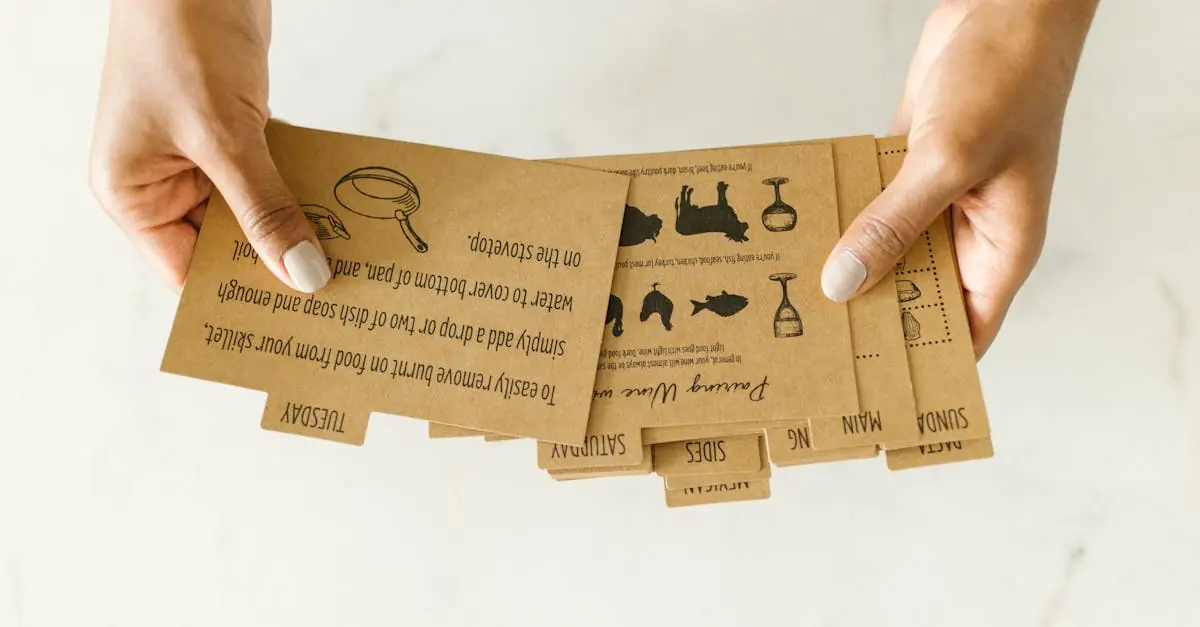When it comes to holiday feasts or Sunday dinners, Sugardale ham steals the show like a rockstar at a sold-out concert. This succulent centerpiece isn’t just a meal; it’s an experience that brings family and friends together around the table. But let’s face it, cooking a ham can feel like trying to solve a Rubik’s Cube blindfolded. Fear not! With the right instructions, you’ll have that ham singing in the oven, and your guests will be showering you with compliments.
Whether you’re a seasoned chef or a kitchen novice, mastering the art of Sugardale ham is easier than you think. Get ready to impress everyone with tender, juicy slices that practically melt in their mouths. Dive into these cooking instructions and transform your ham into the star of the show. After all, who wouldn’t want to bask in the glory of a perfectly cooked ham?
Table of Contents
ToggleOverview of Sugardale Ham
Sugardale ham stands out as a flavorful centerpiece for holiday feasts and family gatherings. This premium ham, known for its rich taste and tenderness, enhances any dining experience. It features a carefully crafted blend of seasonings, resulting in a savory flavor profile that appeals to a wide range of palates.
Cooking Sugardale ham involves simple steps to achieve perfect results. Whether it’s a spiral-sliced or whole ham, attention to temperature and time ensures juicy, tender slices every time. For optimal flavor, many suggest glazing the ham for added sweetness and complexity.
This ham also offers versatility. It can be served hot, with sides, or cold on sandwiches, making it a favorite for various occasions. The residual flavors make great additions to soups and salads.
Nutritional value holds importance as well. Sugardale ham provides protein, essential for a well-balanced meal. Its low-fat content, in moderation, makes it a reasonable choice for health-conscious individuals.
Storage of Sugardale ham is straightforward. Uncooked ham requires refrigeration and should be cooked within a certain timeframe, while cooked ham can be frozen for extended preservation. Guidelines suggested by official sources should be followed to ensure quality and safety.
These features highlight why Sugardale ham remains a popular choice across households, turning ordinary meals into extraordinary experiences.
Preparation Steps
Preparing Sugardale ham involves key decisions and tools that enhance the cooking experience. He or she must consider carefully chosen steps for the best outcome.
Choosing the Right Sugardale Ham
Selecting the appropriate Sugardale ham significantly impacts the final dish. Spiral-sliced options offer convenience and ease, ideal for quick serving at gatherings. Whole hams provide versatility and allow for customization in flavors and glazes. Nutrition preferences also play a role; selecting a leaner cut can cater to health-conscious individuals. Keep in mind that picking the right size depends on the number of guests. A general rule suggests ½ pound per person for bone-in hams and ¼ pound for boneless varieties.
Essential Cooking Tools
Using the correct cooking tools simplifies the preparation of Sugardale ham. Begin with a reliable roasting pan to ensure even cooking. A meat thermometer guarantees precise internal temperatures, achieving that perfect doneness. Basting brushes facilitate coating the ham with glaze, enhancing flavor and appearance. For spiral-sliced ham, having a sharp knife aids in removing slices neatly. Additionally, foil or parchment paper helps retain moisture during cooking, thereby preventing dryness. Collecting these tools beforehand streamlines the cooking process, enabling a smooth experience.
Cooking Methods
Cooking methods for Sugardale ham bring out its rich flavors and tenderness. Various techniques yield delicious results, enhancing any meal.
Baking Sugardale Ham
Baking presents a straightforward way to cook Sugardale ham. Preheat the oven to 325°F. Position the ham on a rack in a roasting pan, adding water to maintain moisture. Cover the ham with foil during most of the baking time. Cooking times vary; aim for 10 to 14 minutes per pound. Use a meat thermometer to ensure the internal temperature reaches 140°F for pre-cooked hams. Allowing the ham to rest before slicing ensures even flavor distribution. This method yields juicy, tender slices perfect for serving.
Glazing Techniques
Glazing Sugardale ham adds a burst of flavor and an appealing finish. Prepare a glaze by combining ingredients such as brown sugar, honey, and mustard. Apply the glaze during the last 30 minutes of baking for optimal caramelization. Brush the glaze over the surface using a basting brush, and return the ham to the oven uncovered. Check every 10 minutes to add more glaze, ensuring an even coating. This technique enhances the visual appeal, creating a beautiful dish that complements the ham’s natural taste.
Cooking Times and Temperatures
Cooking Sugardale ham requires attention to time and temperature to achieve optimal flavor and texture. Proper cooking ensures a tender, juicy outcome.
Internal Temperature Guidelines
Internal temperatures dictate doneness for Sugardale ham. The USDA recommends cooking ham to a minimum internal temperature of 145°F for safe consumption. Using a meat thermometer provides precise readings. For optimal taste and texture, allowing the ham to reach 160°F enhances juiciness. Spiral-sliced ham often requires less cooking time due to its pre-sliced nature, typically needing about 10-15 minutes per pound when reheating. Whole ham may take longer, around 18-20 minutes per pound.
Resting Periods
Resting periods play a crucial role in maintaining moisture. After cooking, let the ham rest for at least 20 minutes. This duration allows juices to redistribute throughout the meat, resulting in flavorful slices. Slicing too early can lead to a drier texture. Additionally, covering the ham loosely with foil during the resting period helps retain warmth. Allowing the ham to rest enables a more enjoyable dining experience with tender, juicy portions ready to serve.
Serving Suggestions
Serving Sugardale ham can elevate any meal, whether it’s a simple weeknight dinner or a festive gathering. Consider pairing ham slices with classic sides like roasted vegetables, mashed potatoes, or a refreshing green salad. Adding a fruit chutney or tangy mustard can enhance the flavor profile and provide a delightful contrast.
Another great option involves using ham in sandwiches. Layering thin slices with cheese, lettuce, and your favorite condiments creates a quick and satisfying meal. For brunch events, a ham and eggs casserole offers a hearty choice that guests will enjoy.
Using leftover Sugardale ham in recipes provides versatility. Incorporating diced ham into soups or salads gives an extra flavor kick while maintaining moisture. Preparing a ham and cheese quiche makes for a delicious breakfast or lunch centerpiece.
Presentation plays a role in serving as well. Arranging sliced ham on a platter with garnishes like fresh herbs or citrus fruits can create an inviting display. Serving some warm rolls or biscuits alongside the ham allows for easy serving options for guests.
Creative toppings, like a honey glaze or spiced apple mixture, can add flair when serving. Dipping sauces or glazes placed in small bowls alongside the ham allow guests to customize their flavors as they prefer.
Finally, don’t overlook the appeal of serving Sugardale ham cold for a charcuterie board. A mix of cheeses, crackers, and fruits can complement the flavors of the ham nicely. These serving suggestions showcase how Sugardale ham can shine in various culinary contexts.
Sugardale ham truly elevates any meal with its rich flavor and versatility. Whether serving it hot for a festive gathering or cold on a charcuterie board, it’s sure to impress. The cooking techniques outlined provide a straightforward approach for achieving tender, juicy slices that everyone will love.
With thoughtful preparation and the right tools, even novice cooks can create a memorable dish. Leftovers offer endless possibilities, from soups to casseroles, ensuring that Sugardale ham remains a delightful presence long after the main event. Embracing this culinary gem will undoubtedly transform ordinary meals into extraordinary experiences.





